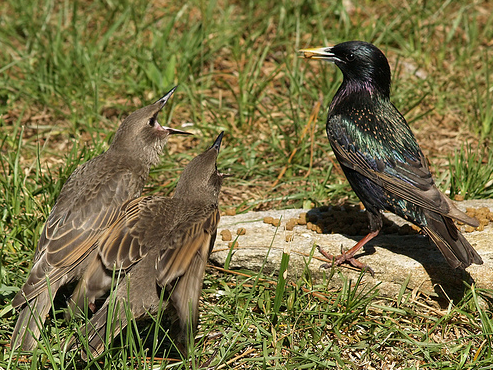| << Chapter < Page | Chapter >> Page > |
In birds, both infanticide and adoption occur in many different species from woodpeckers and hornbills to eagle owls and barn swallows (Hrdy 1979; Stacey and Edwards 1983; Chan et al. 2007; Penteriani and Delgado 2008; and Crook and Shields 1985) (see [link] and [link] ). Moreover, infanticide generally occurs when an adult kills unrelated young (see [link] ). The circumstances and the reasons behind the adoption and infanticide change with the species studied. In European starlings ( Sturnus vulgaris ), for example, males care for brood by incubating eggs and by feeding the young (Smith et al . 1995 and Pinxten and Eens 1994) (see [link] ). Males are facultatively polygynous and will mate with females whose own mates have disappeared (Pinxten et al. 1993). However, if these females had already copulated with the males that disappeared, the replacement males will either adopt or kill the brood. Their choice is dependent on the expected paternity in the females’ current clutches (if he arrives before it is laid) or how fast the female will mate with him for the next clutch (Smith et al. 1996).

Infanticide is not so common in other species of birds. In Tree Swallows ( Tachycineta bicolor ), for example, males generally choose to take care of a female’s brood, despite low paternity, instead of committing infanticide (Whittingham et al. 1993), and in yellow-headed blackbirds (Xanthocephalus xanthocephalus), males actually use their adoption of unrelated broods to attract females for mating (Gori et al . 1996).
Males, however, are not the only ones who commit infanticide or adopt unrelated broods. In fact, there are some species of birds where the female commits infanticide. In these cases, like the house sparrow, the replacement mates are females (Veiga 2004). Moreover, infanticide does not always occur when one individual replaces another. In guira cuckoos, members of the communally breeding group may actually kill the hatchlings of the group in order to produce more of the offspring themselves.
| Table of Species that Adopt or Commit Infanticide | |||
| Common Name | Latin Name | Common Name | Latin Name |
| Acorn woodpecker | Melanerpes formicivorus | Guira cuckoo | Guira guira |
| American kestral | Falco sparverius | House sparrow | Passer domesticus |
| Barn Swallow | Hirundo rustica | Mexican jay | Aphelocoma ultramarina |
| Eagle owls | Bubo bubo | Oriental pied hornbill | Anthracoceros albirostris |
| Eastern bluebird | Sialia sialis | Tree swallow | Tachycineta bicolor |
| European starling | Sturnus vulgaris | Yellow-headed blackbird | Xanthocephalus xanthocephalus |
European starlings, like most species of birds, form social pair bonds between mates. Because most avian young require intense parental care, these mating bonds allow the two adults birds to share the burden of feeding, raising and protecting the young (Clutten-Brock 1991; Burley and Johnson 2002). Many bird species engage in this biparental care, even in polygynous species like the European starling (Smith et al. 1996). However, these pair bonds are rarely permanent and are broken up as individuals die of predation or starvation or are forced to leave. For example, when a new male wins dominance over a new territory, the previously dominant male has to abandon the territory and any females in the area. These new males then take over and court and copulate with the females. These males are called “replacement males.”

Notification Switch
Would you like to follow the 'Mockingbird tales: readings in animal behavior' conversation and receive update notifications?